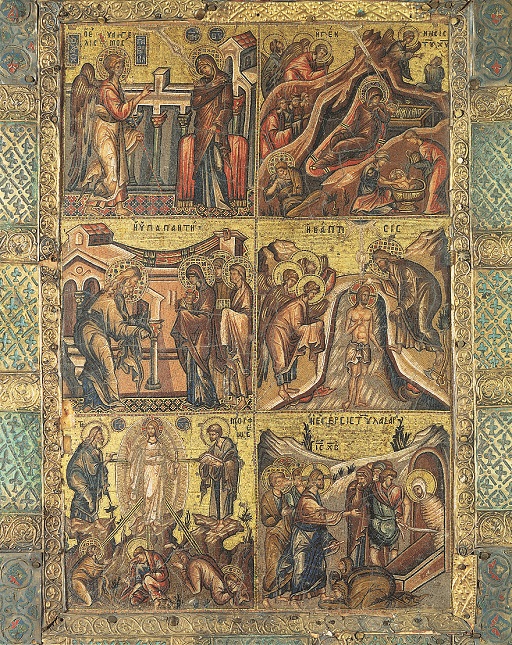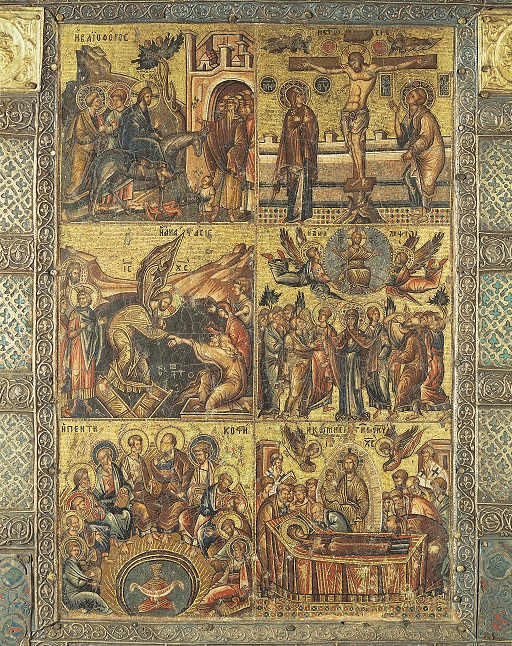Appendix 2
Byzantine iconography (from the Greek εικονογραφία, eikonographía, lit. ‘writing in images’) is based on the Gospel / Bible narrative, or on Apocryphal Gospel narrative. The latter were not part of the liturgy but were nevertheless widespread among the faithful. One of the most popular apocryphal gospels was the Gospel of Nicodemus, probably produced in the 5th century (Kazhdan, 1991, vol. 2, p. 1472), from which a number of iconographic subjects have been drawn. Below is a list with the most popular iconographic subjects and their respective Gospel narrative passage.
- Annunciation to the Virgin – Luke 1:26-38
- Nativity of Christ – Matthew 1:18-25 and 2:1-23; Luke 2:1-20
- Presentation of Christ in the Temple – Luke 2:22-39
- Baptism of Christ – Matthew 3:13-17; Mark 1:9-11; Luke 3:21-22; John 1:29-34
- Transfiguration of Christ – Matthew 17:1-9; Mark 9:2-9; Luke 9:28-36
- Raising of Lazarus – John 11:1-45; also in the Gospel of Nicodemus
- Entry into Jerusalem – Matthew 21:1-9; Mark 11:1-10; Luke 19:29-40; John 12:12-15
- Washing of the Feet – John 13:3-11
- Last Supper – Matthew 26:17–29; Mark 14:12–25; Luke 22:7–38; and I Corinthians 11:23–25
- The Prayer in Gethsemane – Matthew 26:36-46; Mark 14:32-42; Luke 22:39-46
- Betrayal – Matthew 26:47-56; Mark 14:43-52; Luke 22:47-53; John 18:2-11
- Carrying of the Cross – Matthew 27:31-32; Mark 15:20-21; Luke 23:26-31; John 19:17; also in Gospel of Nicodemus
- Crucifixion – Matthew 27:33-56; Mark 15:22-41; Luke 23:33-49; John 19:17-37
- Descent from the Cross – Matthew 27:57-59; Mark 15:43-46 and Luke 23:50-53; John 19:38-39
- Lamentation – only in the Gospel of Nicodemus
- Entombment – Matthew 27:57-61; Mark 15:42-47; Luke 23:50-55; John 19:38-42
- Harrowing of Hell / Anastasis / Resurrection – only in the Gospel of Nicodemus
- Holy Women at the Tomb – Matthew 28:1-8; Mark 16:1-8; Luke 24:1-10; John 20:1-18
- Ascension – Mark 16:19; Luke 24:50-52; Acts of the Apostles 1:9-11
- Pentecost – Acts of the Apostles 2:1-13
- Dormition of the Virgin – this scene does not form part of the Gospel narrative, but it is based on Homilies of Church Fathers. The representation of this scene is directly related to the vast popularity of the Virgin among Christian faithful as the Mother of God, the instrument of Incarnation and the main intercessor to her Son for the salvation mankind and their souls.
Please note that this list includes the most frequently depicted sacred events depicted in Byzantine iconography, but it is by no means exhaustive. (For example, the Flagellation of Christ, an episode from His Passion [see Figure 8b], a popular scene in western art which rarely finds its way into Byzantine iconography, has not been included in the list.) If you’d like to investigate the relationship between biblical narrative and visual representation, you might be interested in the ‘Visual Commentary on Scripture’ project: VCS | Visual Commentary on Scripture: Encounter the Bible through Art [Tip: hold Ctrl and click a link to open it in a new tab. (Hide tip)]
A useful visual guide for this appendix is Figure 15, a micro-mosaic diptych which depicts twelve of the most popular scenes in Byzantine art and iconography (the so-called Dodekaorton).


These scenes are:
Left panel (top to bottom, left to right): Annunciation, Nativity, Presentation of Christ in the Temple, Baptism, Transfiguration, Raising of Lazarus.
Right panel (top to bottom, left to right): Entry into Jerusalem, Crucifixion, Harrowing of Hell (i.e., the preferred iconography in Byzantine art for the Resurrection of Christ), Ascension, Pentecost, Dormition of the Virgin.
